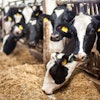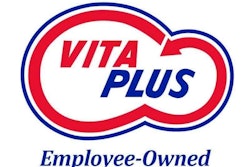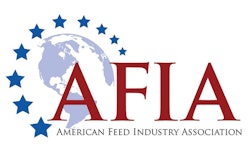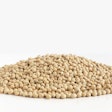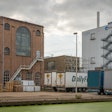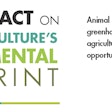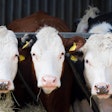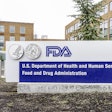
If you haven't sanitized every inch, it hasn't been sanitized. That was the message from Richard Obermeyer, director of Feed Production for Aviagen North America, during his presentation at AFIA's Feed Production Education Program at the IPPE Marketplace on Thursday.
The presentation,Food Safety and Biosecurity Practice Relating to Feed Manufacturing Facilities, went over the attributes of viruses and bacteria, how they make it into feed facilities, and how they make a facility's biosecurity better.
Obermeyer's first tip was to make sure there is no standing water near a facility, especially in a place that a truck can drive through or workers need to walk through. Standing water is an excellent environment for viruses and bacteria to propagate, and employees or trucks moving through the standing water spreads the contamination to other areas.
有消毒的第一步mill is getting rid of standing water, which includes everything from a pothole to water a disinfection wash. He also recommends doing everything possible to stop trucks from dripping anything into your receiving pit, and keeping equipment maintained so water has no way of leaking into the product.
Water and grain make feed mills very attractive to another primary source of contamination, rodents and birds. These pests carry pathogens with them, eating infected grain and then bringing the pathogens to different parts of the mill or the mill in the first place.
Dust is the final giant virus and bacteria spreader. More of an issue with bacteria than viruses, dust gives these contaminates a ride to different facility areas when stirred up. It allows the bacteria to get into the nooks and crannies on people, vehicles and equipment. It is even possible for dust to bring in pathogens from a nearby field during harvest.
What can be done? Obermeyer gave some helpful hints:
- Remove any standing water and make sure areas where water collects has proper drainage.
- Clean with old fashion elbow grease, don't use things that will blow dust around like compressed air.
- Make cleaning a routine task. It's better to clean an area often than let the problem pile up. Employees will be less likely to miss a spot this way.
- Make sure every part of an area has been sanitized. Missing even a small part allows pathogens to spread again quickly.
- Maintain equipment. Not only is this important from a quality and safety standpoint, but equipment produces less duct and doesn't let in water when adequately maintained.
The feed industry has a responsibility to its customers and its bottom line to ensure its facilities are as sanitary as possible. Taking necessary steps to improve a mill's sanitation will pay off in the long run.

.jpg?auto=format%2Ccompress&crop=faces&fit=crop&h=48&q=70&w=48)

